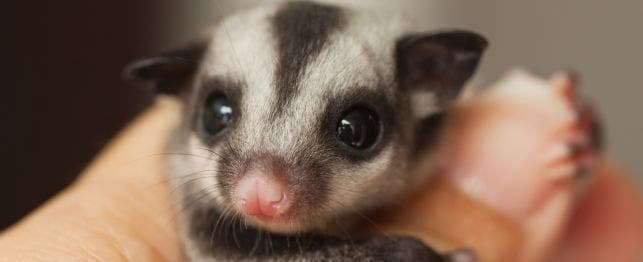
How to Train Your Sugar Glider
The key to training a sugar glider is to start young. A baby sugar glider is an open heart just looking for someone to love.
“Assuming you’re starting with a youngster, I recommend you get them when you have two or three days off from work,” suggests Sharon Massena, a breeder and owner of Massena’s Menagerie in Auburn, Wash. “Just hold him cupped in your hands as much as possible for the first 48 hours. After that, he’ll be pretty well in tune with you and won’t be afraid of you.”
Some glider breeders recommend new glider owners carry their animal around with them on their body, tucked into a shirt, for the first couple of days. (Hint to all who try this: Wear an undershirt. Glider claws can be murder on human skin.)
In fact, you’ll become your sugar glider’s favorite “tree,” a tall, comfy, secure place to run to when the rest of the world looks frightening, Massena says.
Be Consistent and Positive
Gliders have cat-like personalities. They do what they want to do, and pretend not to hear you if you want them to do something they’re not interested in doing. But with consistent effort, your glider can learn to come when you call him. This is a good trick to know if you take your pet outside and he accidentally scampers away.
The best way to establish a trusting bond with a glider is through positive reinforcement. The animals do not react well to harsh discipline. Never attempt to hit or flick them with your finger. They are small and delicate, and you could hurt them without realizing it.
Better still, keep watch on your glider and reward good behavior with a treat. “They will work for rewards,” Massena says. Some favorites are nuts, especially slivered almonds, raisins, cereal – finger foods you might give a toddler. “They can eat nearly anything,” Massena says. “My gliders like whole grain rice and scrambled eggs.” Just use common sense to avoid feeding it heavy or sugar-laden foods that aren’t good for humans either.
House-Training
House-training typically takes very little time, Massena says. Gliders typically are ready for a potty stop within the first couple of minutes of waking up, then they’re good for several hours. Make sure they’re in their cage, over an appropriate corner or box, when nature calls.
Since sugar gliders are noctural by nature, they spend most of the day asleep and don’t really become active until after dark. “Lots of people carry them to work in their pockets all day, then they come to life at night,” Massena says. “Of course, I don’t recommend that you take them into restaurants.” She knows one glider who, whenever a sack of fast food is brought into the car, dives head first into the sack. “He loves French fries,” she says.